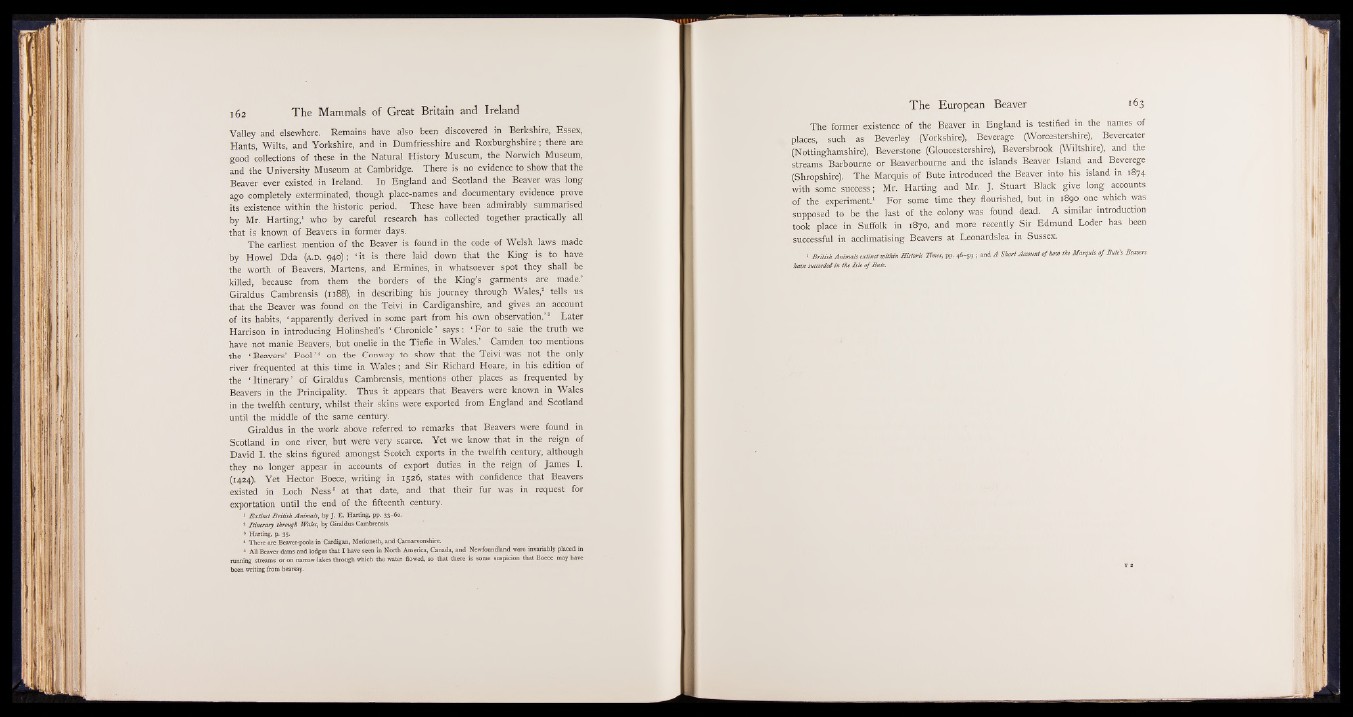
Valley and elsewhere. Remains have also been discovered in 'Berkshire, Essex,
Hants, Wilts, and Yorkshire, and in Dumfriesshire and Roxburghshire; there are
good collections of these in the Natural History Museum, the Norwich Museum,
and the University Museum at Cambridge. There is no evidence to show that the
Beaver ever existed in Ireland. In England and Scotland the Beaver was long
ago completely exterminated, though place-names and documentary evidence prove
its existence within the historic period. These have been admirably summarised
by Mr. Harting,1 who by careful research has collected together practically all
that is known of Beavers in former days.
The earliest mention of the Beaver % found in the code of Welsh laws made
by Howel Dda (a .d . 940); ‘ it is there laid down that the King;:| | to have
the worth of Beavers, Martens, and Ermines, in whatsoever spot they shall be
kilttlv because from them the borders of the King’s garments are made.’
Giraldus Cambrensis ©88), in describing his journey through Wales,® tells us
that the Beaver was found on the Teivi in Cardiganshire, and gives an account
of its habits, ‘ apparently derived in some part from his own observation. 8 Later
Harrison in introducing Holinshed’s ‘ Chronicle say s : ‘ For to saie the truth we
have not manie Beavers, but onelie in the Tielie in Wales.’ -Camden too mentions
the ‘ Beavers’ Pool ’ 4 on the Conway to show that the Teivi -was not the only
river frequented at this time in Walefri and S ir Richard Hoare, in his edition of
the ‘ Itinerary’ of Giraldus Cambrensis, mentions other places- as frequented *
Beavers in the Principality. Thus it appears that Beavers were known in Wales
in the twelfth century, whilst their skins were exported from England and Scotland
until the middle of the same century.
Giraldus in the work above referred to remarks that Beavers were found in
Scotland in one river, but were very scarce. Yet we know that in the reign of
David I. the skins figured amongst Scotch exports in the twelfth century, although
they no longer appear in accounts of export duties in the reign of James I.
(1424). Yet Hector Boece, writing in 1526, states with confidence that Beavers
existed in Loch Ne s s' at that date, and that their fur was in request' for
exportation until the end of the fifteenth century.
1 Extinct British Animals, by J. E. Harting, pp. 33-60.
* Itinerary through Wales, by Giraldus Cambrensis.
3 Harting, p. 35.
4 There are Beaver-pools in Cardigan, Merioneth, and Carnarvonshire.
s All Beaver dams and lodges that I have seen in North America, Canada, and Newfoundland were invariably placed in
running streams or on narrow lakes through which the water flowed, so that there is some suspicion that Boece may have
been writing from hearsay.
The former existence of the Beaver in England is testified in the names of
pW s such as Beverley (Yorkshire), Beverage (Worcestershire), Bevercater
(Nottinghamshire), Beverstone (Gloucestershire), Beversbrook (Wiltshire), and the
streams Barbourne or Beaverbourne and the islands Beaver Island and Beverege
(Shropshire). The Marquis-jfjf Bute introduced the Beaver into his island in 1874
with some 'success; Mr. Harting and Mr. J . Stuart Black give long accounts
of the experiment,.1 For some time they flourished, but in 1890 one which was
supposed to be the last of the colony was found dead. A similar introduction
took place in Suffolk in 1870, and more recently S ir Edmund Loder has been
successful in acclimatising Beavers- at Leonardslea in Sussex.
• British Animals extinct within Historic Tims, pp. 46-59 ; «>6 A Short Account o f how the M ar,nil of Bale's Benners
have succeeded in the Isle o f Bute. .